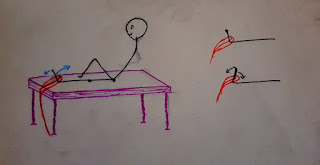Activation and Strengthening of Tibialis Anterior

Tibialis Anterior The Tibialis anterior is a main dorsiflexor of the foot. But due to various pathological and biomechanical changes in our body, we tend to use other syregist dorsiflexors rather than Tib. Anterior. This leads to the inactivation of Tibialis Anterior and that can cause various medical conditions. Causes & Effects The main causes include, Hemiplegia Parkinsons Bad Gait pattern Effusion/ Edema The adverse effects include, Overactivity of toe extensors Defect in Anticipatory postural adjustment (APA) Contralateral tensor fascia latae (overactive) Medial tibila stress syndrome (Shin splints) Palpation In order to palpate the Tibialis Anterior of a patient, First get him in supine lying and place a resisting hand on the medial side of the distal foot. By putting the resistance we resist the Dorsiflexion and Inversion (By Tib Anterior). As the patients dorsiflexes, the tendon of Tib Anterior is easily visible on the anterior/medial side of the ankle. We palpate the mu
